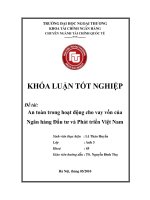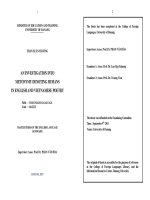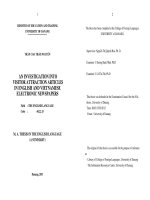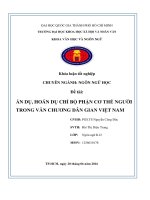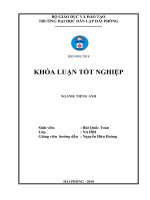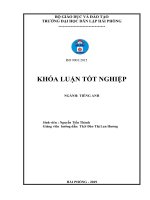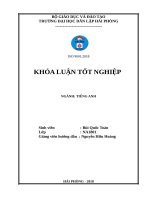Khóa luận tốt nghiệp an investigation of linguistic features of some english and vietnamese advertising slogans
Bạn đang xem bản rút gọn của tài liệu. Xem và tải ngay bản đầy đủ của tài liệu tại đây (729.7 KB, 61 trang )
VIET NAM NATIONAL UNIVERSITY OF AGRICULTURE
FACULTY OF EDUCATION AND FOREIGN LANGUAGES
BA THESIS
AN INVESTIGATION OF LINGUISTIC FEATURES OF
SOME ENGLISH AND VIETNAMESE ADVERTISING
SLOGANS
NGHIÊN CỨU CÁC ĐẶC ĐIỂM NGÔN NGỮ
CỦA MỘT SỐ KHẨU HIỆU QUẢNG CÁO
TRONG TIẾNG ANH VÀ TIẾNG VIỆT
Student
: NGUYEN PHUONG ANH
Student code : 621246
Major
: ENGLISH
Supervisor
: NGUYEN THI NGOC THU, M.A
HaNoi - 2021
VIET NAM NATIONAL UNIVERSITY OF AGRICULTURE
FACULTY OF EDUCATION AND FOREIGN LANGUAGES
BA THESIS
AN INVESTIGATION OF LINGUISTIC FEATURES OF
SOME ENGLISH AND VIETNAMESE ADVERTISING
SLOGANS
NGHIÊN CỨU CÁC ĐẶC ĐIỂM NGÔN NGỮ
CỦA MỘT SỐ KHẨU HIỆU QUẢNG CÁO
TRONG TIẾNG ANH VÀ TIẾNG VIỆT
Student
: NGUYEN PHUONG ANH
Student code : 621246
Major
: ENGLISH
Supervisor
: NGUYEN THI NGOC THU, M.A
HaNoi - 2021
CERTIFICATE OF ORIGINALITY
I, the undersigned, hereby certify my authority of the study project report
entitled “An investigation of linguistic features of some English and
Vietnamese advertising slogans.” submitted in partial fulfillment of the
requirements for the degree of Bachelor in English Language. Except where the
reference is indicated, no other person‟s work has been used without due
acknowledgement in the text of the thesis.
Hanoi, 2021
Nguyen Phuong Anh
Approved by
SUPERVISOR
(Signature and full name)
Date:……………………
i
ACKNOWLEDGEMENT
Hanoi,
First, with the deepest and most sincere affection, allowing me to express
my gratitude to all the individuals and organizations who have facilitated
support and help throughout the learning and research process.
With deepest gratitude, sincerely thanks to M.A Nguyen Thi Ngoc Thu, my
supervisor who gave me useful guidance and advice that helped me finish my
research successfully. Because of the continuous support of my B.A research
proposal, for her patience, motivation, enthusiasm, and immense knowledge.
Her guidance helped me in all the time of research and writing of this thesis. I
could not have imagined having a better advisor and mentor for my B.A study.
Second, I would like to express thanks to all the teachers in the Board of
directors of the Vietnam National University of Agriculture and the teachers of
the Faculty of Education and Foreign Languages for creating a favorable
condition for me to have the chance for being done with my B.A study.
Last but not least, I am grateful to my family for giving birth to me in the
first place and supporting me spiritually throughout my life and all the lovely
members in my B.A thesis group who contributed to help me complete my
research.
I perceive this opportunity as a big milestone in my career development. I
will strive to use gained skills and knowledge in the best way to attain desired
career objectives.
Sincerely,
ii
ABSTRACT
Due to the extreme current strong demand, every product requires efficient
strategies to present its image to its potential buyers and a great slogan is an
amazing way of proceeding. Advertising by slogans has gradually given great
attention to the importance of its importance in the living conditions of people
among various sorts of advertisements. There are nonetheless distinctions in the
language characteristics that need to be examined between English and
Vietnamese advertising slogans. The study “An investigation of linguistic
features of some English and Vietnamese advertising slogans” is conducted to
identify some distinguishing phonological, lexical and syntactic characteristics.
The total of 60 advertising slogans are collected from well-known English and
Vietnamese newspapers and magazines, and analyzed to support the aim of the
study. The finding of the research emphasizes the similarities and differences in
terms of phonological, lexical and syntactic features between English and
Vietnamese advertising slogans. The thesis was carried with the hope to
implement some suggestions for teaching and learning business English, and
some advice for advertisers.
iii
TABLE OF CONTENTS
Certificate of originality ......................................................................................... i
Acknowledgement ................................................................................................. ii
Abstract ................................................................................................................ iii
Table of contents .................................................................................................. iv
PART 1: INTRODUCTION.............................................................................. 1
1. Rationale for the study ...................................................................................... 1
2. Aims and objectives of the study ...................................................................... 2
3. Research questions ............................................................................................ 2
4. Scope of the study ............................................................................................. 3
5. Significance of the study ................................................................................... 3
6. Design of the study ............................................................................................ 3
PART 2: DEVELOPMENT ............................................................................... 5
Chapter 1: LITERATURE REVIEW ............................................................... 5
1.1. Review of previous studies (at home/abroad) ................................................ 5
1.2. Review of theoretical background ................................................................. 8
1.2.1. Statement of theoretical framework chosen ................................................ 8
1.2.2. Review of theoretical preliminaries employable as tools for conducting the
thesis .................................................................................................................... 10
1.3. Summary ...................................................................................................... 11
1.3.3. Advertising Slogan as an Essential Part of an Advertisement .................. 17
Chapter 2: METHODOLOGY ........................................................................ 20
2.1. Research governing principles ..................................................................... 20
2.1.1. Research methodology .............................................................................. 20
2.1.2. Research setting/context............................................................................ 20
2.1.3. Procedures ................................................................................................. 21
2.1.4. The Analysis .............................................................................................. 22
iv
Chapter 3: FINDINGS AND DISCUSSIONS ................................................ 35
3.1. Findings and discussions on graphetic features ........................................... 35
3.2. Findings and discussions on phonological features ..................................... 35
3.3. Findings and discussions on lexical features ............................................... 36
3.4. Findings and discussions on syntactic features ............................................ 40
3.6.1. Similarities ................................................................................................ 42
3.6.2. Differences ................................................................................................ 43
PART 3: CONCLUSION ................................................................................. 45
1. Recapitulation.................................................................................................. 45
2. Concluding remarks ........................................................................................ 45
3. Limitations of the study .................................................................................. 46
4. Suggestions for further study .......................................................................... 46
REFERENCES .................................................................................................... 47
APPENDIX I ....................................................................................................... 49
APPENDIX II ..................................................................................................... 51
v
LIST OF TABLES AND FIGURES
Table 3.1: Graphetic Features of English and Vietnamese Advertising Slogans
............................................................................................................................. 35
Table 3.2: Phonological Features of English and Vietnamese Advertising
Slogans ................................................................................................................ 36
Table 3.3: Lexical Features in English and Vietnamese Advertising Slogans ... 36
Table 3.4: Syntactic Features in English and Vietnamese Advertising Slogans 40
vi
PART 1: INTRODUCTION
1. RATIONALE FOR THE STUDY
Nowadays, in a developed world, thousands of new products and services
are introduced each day, which makes advertising become a real art - the art of
informing and persuading customers. In the context of a fiercely competitive
market, the businesses allocate huge budgets to create their brand image.
Slogans can be considered the heart of advertisements wherever they appear.
Slogans are the most important and condensed messages advertisers would like
to send to their customers. Sharp and intelligent slogans can help advertisers
leave unforgettable impressions on their potential customers‟ minds.
The slogan is the most commonly used text form that makes the brand
appear compellingly unique among alternatives and it is a part of marketing that
plays an important role in attracting customers. As creating an attractive slogan
is not an easy task, slogan designing has now become a lucrative industry. It
requires a sophisticated linguistic insight of phonology, lexicology, syntax as
well as semantics and pragmatics.
On the other hand, what can be called a successful slogan is still a
question. The answer depends on the area of products and services the slogan is
used for, the country or geographical regions it is used in and maybe the
population of its target customers. Therefore, choosing one kind of products or
services to study the slogans used in it should bring more thorough and detailed
results of aspects of language exploited.
Good slogans are easy to keep in mind, meaning that they should be short,
easy to remember, and easy to know by heart. According to Kevin J.Clancy,
President and CEO of Marketing Consulting Copernicus, "Creating a slogan
means finding two or three words or phrases and etching it into the consumer's
mind. If you succeed, people will unconsciously decide to buy your product and
talk about it with other consumers." So that all official business slogans are
produced carefully by professional slogan creators. When making a successful
1
slogan, they employ a wide variety of techniques to portray their message in a
concise, informative and persuasive way. However, the question of creating a
good and successful slogan to bring in customers‟ minds the image of the
product and encourage them to buy is not always at ease.
Therefore, “An investigation of linguistic features of some English and
Vietnamese advertising slogans.” is intentionally carried out to provide some
useful knowledge of language used in advertisements for English teachers and
learners as well as Vietnamese advertisers in order to understand and use
advertising language more effectively in the future work and integrate into the
international environment. The use of just a few words in a slogan proves to be
harder than it appears. Hence, the study on some successful slogans promises a
lot of interesting facts in the art of using language among advertisers.
2. AIMS AND OBJECTIVES OF THE STUDY
The aim of this study is to investigate the typical linguistic features
including lexical, syntactic features and stylistic devices of advertising slogans
in English and Vietnamese. From those characteristics, we could find out the
similarities and differences in the language features of English and Vietnamese.
To achieve this aim, two objectives are set. Firstly, we analyze the linguistic
features, the syntactic structures and the stylistic devices used in advertising
slogans in English and Vietnamese (phonetics, lexicology, grammar, semantics,
pragmatics). Secondly, the study will compare the slogans between English and
Vietnamese to figure out the similarities and differences. From this investigation
and comparison, some hints can be drawn for Vietnamese advertising language
in order to improve the effectiveness and profession of Vietnamese advertising.
3. RESEARCH QUESTIONS
Due to the aims and objectives, the study is conducted to answer two
following question:
1. What are the linguistic features of English and Vietnamese advertising
slogans ?
2
2. What are the similarities and the differences from the linguistic features of
certain English and Vietnamese advertising slogans ?
4. SCOPE OF THE STUDY
The study investigated a total of 60 popular advertising slogans in English
and Vietnamese. It focuses on linguistic features used in these advertising
slogans like phonetics, lexicology, grammar, semantics, and pragmatics. And it
offers most of the similarities and the differences from the linguistic features of
certain English and Vietnamese advertising slogans.
It is impossible for an B.A thesis to cover such a broad topic of business
slogans. Therefore certain stylistic features of some English and Vietnamese
advertising slogans were chosen to take into consideration. The population of 30
English advertising slogans and 30 Vietnamese ones covers mostly all famous
brands in Vietnam and foreign countries, they are respectively divided into
common categories (finance and banking; telecommunication, broadcasting and
publishing; food and drinks; fashion) with an equal number of slogans in each
category.
5. SIGNIFICANCE OF THE STUDY
The values of the study lie in both theoretical and reality aspects.
Theoretically, the research helps to find out linguistic features utilized in these
famous advertising slogans like phonetics, lexicology, grammar, semantics, and
pragmatics. Practically, it could be beneficial for the current knowledge field
and for teachers and students of marketing faculties, slogan creators or local and
nation authorities in applying those discourse features to the act of advertising.
6. DESIGN OF THE STUDY
Part 1 entitled “INTRODUCTION” provides the reason why the topic is
chosen. It then provides the aim and objectives of the study. It is also in this
section that we are concerned with the scope and the design of the study.
Part 2 named “DEVELOPMENT” deals with the main contents of the
study.
3
Chapter 1 “Literature review” has considered a slight overview of some
previous research on the same subject both in English and Vietnamese. It begins
with the concept of business slogan and advertising slogan, and then provides a
review of some previous works done on advertising language both in English
and Vietnamese. It is followed by briefly looking at the language of advertising
as a form of communication in order to find out the basic functions that an
advertising message is intended to accomplish. It, later on, provides some
classifications of different types of advertisements and the popular structure of
an advertisement. After that, it gets insights into the term “advertising slogan”,
its definition and its characteristics.
Chapter 2 has started with the procedures of the investigation that refers to
the approach of the study and the method to collect and analyze the collected
data to help the author achieve the best results in the study.. The analysis is then
presented in detail in terms of graphology, phonology, lexicology, syntax and
semantics. In this analysis, some advertising slogans – both in English and
Vietnamese – are chosen to support the argument.
Chapter 3 focuses on presenting findings of the research and discussions.
The discussion comes after statistical results for each stylistic feature. It is the
basis of the later conclusions.
Part 3 “CONCLUSION” provides the recapitulation of main ideas, the
limitations of the study and some suggestions for further research.
The study is closed with the references and the appendix of English and
Vietnamese advertising slogans that are used for the analysis.
4
PART 2: DEVELOPMENT
Chapter 1: LITERATURE REVIEW
1.1. REVIEW OF PREVIOUS STUDIES (AT HOME/ABROAD)
In comparison to the well-established advertising industries in the United
States and Europe, advertising operations in Vietnam are relatively new and
inexperienced. Because of this economic and sociological fact, there is a
disparity in the amount of research done in this sector in Vietnam and other
nations.
Advertising is seen as a business in the United States and Europe. There
have been research on the subject of advertising language, including several
well-known research like: “English in advertising: A linguistic study of
advertising in Great Britain” by Geoffrey N.Leech (1996), “Advertising as
communication” by Gillian Dyer (1982), “English for sale: A study of the
language of advertising” by Lars Hermeren (1999), or “The discourse of
advertising” by Guy Cook (2001). This is the group of publications that is most
welcome not only to language major students, but also to untrained readers.
These studies are generally about advertising and attack the advertisers'
audience. Because these are really successful in-depth research aimed at
assessing concepts that are closely related to advertising in practical terms. On
the contrary, there are certain limits because each study just focuses on one
theoretical topic and does not cover all of them. Following these researches I can
analyze „what is advertising‟ and „how many features related directly to the
advertising‟.
There are also some studies which focus on certain language features of
advertisements. Some of these are “Selling America: Puns, language and
advertising” by Michel Monnot (1982); “Pictorial Metaphor in Advertising” by
Char Forceville (1998); “Advertising language: A pragmatic approach to
advertisements in Britain and Japan” by Keiko Tanaka (1994). In Vietnam,
5
some notable researches on the language of advertising include two PhD thesis
done by Mai Xuan Huy (2001) on “Các đặc điểm của ngôn ngữ quảng cáo dưới
ánh sáng của lý thuyết giao tiếp” (Features of advertising language in the light
of communicative theory) and Ton Nu My Nhat (2005). It is worth mentioning
that these studies all compare and focus on the most common linguistic features
of advertising language, in which they make a contrasting comparison based on
many theories about the function of advertising such as: "puns, metaphor,
pragmatic and communication". It can be seen that the close connection of the
application of linguistic features in advertising creation.They are not only useful
for language learners to be able to combine those detailed theoretical knowledge
but also paint a general picture of advertising language features for individual
studies. From there, it is possible to find out the differences and similarities of
foreign language characteristics between the world in general and with Vietnam
in particular.
Besides, there are many articles on the matter of advertising language
which are collected by Nguyen Kien Truong in 2004 in a book called “Quảng
cáo và ngôn ngữ quảng cáo: (Advertising and the language of advertising).
Also, there are some MA theses carried out at institutional level. For example, in
Vietnam National University, Hanoi College of Foreign Languages, a thesis on
advertising language used in trade was studied “A thesis on advertising
language used in trade studied” by Hoang Thi Thuy in 2005 , “Presupposition
and Implicature in English and Vietnamese Advertising Slogans” by Tran Thien
Tu in 2007 and another on “An Investigation into the Style of the English
Language Used in Advertising Slogans issued by some World-Famous Airlines”
by Bui Thi Bich Thuy (2008). All these works have revealed typical and very
interesting features of advertising language in general and slogans in particular.
Also in the spirit of inheriting and upholding the previous studies, what is being
done hereafter is to partially find out some similarities and differences in certain
6
stylistic features between some English and Vietnamese advertising slogans. I
hope that my small contribution will be useful in the future.
Thanks to these incredibly effective writings, we can confirm the
importance of slogans in the worldwide advertising industry. So this study will
give an evaluation of two in the representative works both domestically and
internationally:
First of all, the following book Discourse (Language Teaching: A Scheme
for Teacher Education) by Guy Cook (1989:7) was published by Oxford Univ
Press seems to provide relatively sufficient information so that we can shape a
clear image of discourse in our minds. The book is about the definition of
discourse; it may or may not comprise one or more constructed grammatical
phrases. It can have grammatical “mistakes” in it, and often does. „Discourse
can be anything from a grunt or single expletive, through short conversations
and scribbled notes right up to Tolstoy‟s novel, WAR AND PEACE, or a lengthy
legal case.‟ The author argues that the matter is not its conformism to control,
but that it communicates and is recognized by its receivers as coherent. Based on
this definition, advertisements and advertising slogans are undeniably discourses
because these advertisements themselves are messages from manufacturers or
service providers to their customers and slogans are those messages in the most
concise ways.
In like manner, we can figure out the importance of the ways to make
advertising slogans from “An investigation into the style of the english language
used in advertising slogans issued by some world - famous airlines” by Bui Thi
Bich Thuy (2008). The author explains her findings in terms of the features of
the English language employed in airline advertising slogans, as well as her
conclusions on the percentage of slogans that use such qualities. It summarizes
the findings, discusses the study's implications for the creation of advertising
slogans
in
general,
and
airline
slogans
in
particular,
and
makes
7
recommendations for further research. The language of advertisements in
general and of slogans in particular is an interesting issue to be studied by both
linguists and copywriters as it requires so much effort in conveying such
profound meanings via such condensed messages. In this study, a number of 50
airlines‟ slogans have been investigated to find out the mostly-shared
characteristics in the English language employed by the most successful airlines
in the world. The investigation has helped the author to draw some conclusions
which will obviously be appreciated by airline advertisers.
All of these projects have shown common and fascinating characteristics
of advertising language in general, and slogans in particular. As a result, looking
at how to employ lexical, syntactic, and stylistic elements in advertising slogans
will provide valuable insights. It also aids in distinguishing the similarities and
differences in the language of slogans between Vietnamese and international
firms, in the spirit of inheriting and sustaining prior research. Since then, we've
learned more about the companies' development paths, business strategies, and
metaphorical meanings conveyed by their slogans. I hope that what is being
done now will be beneficial in the future.
1.2. REVIEW OF THEORETICAL BACKGROUND
1.2.1. Statement of theoretical framework chosen
An indispensable thing is the information of slogans, advertising and
advertising slogan:
First, the word slogan is derived from a Scottish Gaelic word sluaghghairm pronounced as slogorm which used to mean battle-cry. According to
Longman Dictionary of Contemporary English (1995), “a slogan is a short
easily-remembered phrase used by an advertiser, a politician, etc.” Therefore,
in general, a slogan is a memorable motto used in political, commercial,
religious, and other contexts as a repetitive expression of an idea or purpose. A
slogan is kind of a condensed message of the whole advertisement which
8
advertisers want their customers to remember most about the products. A slogan
is extremely effective for strengthening the product's identity. Though used in
conjunction with a logo to represent the product, a slogan is regarded to be more
potent than a logo since consumers frequently remember and repeat a product's
tagline rather than drawing its logo.
Slogans can make the businesses stand out, but if not executed
successfully, the wrong advertising slogan can also backfire. There are many
cautionary tales of famous ad slogans gone wrong. Companies of all sizes,
especially global corporations, have stumbled in the past when marketing their
brands abroad. Consider an example of a slogan gone wrong by Pepsi when they
were marketing their slogan, "Pepsi Brings You Back to Life", in Europe this
slogan was actually well accepted. But in China the slogan meant "Pepsi Brings
Your Ancestors Back from the Grave." Clearly, that was not what Pepsi planned,
and if it had not been changed, it could have hurt the Pepsi brand severely.
Second, according to Bovee (1992), „Advertising is the nonpersonal
communication of information usually paid for and usually persuasive in nature
about products, services or ideas by identified sponsors through the various
media.‟(Bovee, 1992, p.7) Advertising is the nonpersonal delivery of
information since it is not directed at any one individual but rather at the general
public or a specific group of individuals. It differs from interpersonal
communication in that both presenters and listeners are present to interact with
one another. According to Churchill, Jr and Peter (1998): „Advertising is noted
as any announcement or persuasive message placed in the mass media in paid
or donated time or space by an identified individual, company, or organization
to serve a number of audience about products and persuade or remind them of
buying, to convey information about the organization itself or issues important
to the organization in order to create or enhance perception of the quality or
9
reliability of a product, thus encouraging customer loyalty and repeat
purchases‟. (p.142)
To summarize, we may conclude from the above two definitions that
advertising slogans are a method of communicating and attracting clients
through meaningful words, phrases, or sentences into which advertisers place
information. An advertising slogan is the heart of the business since it combines
work, brainpower, and is the first image buyers think of when they consider the
brand. In the particular case of an advertising slogan, it is a verbal logo normally
appearing just beneath or beside the brand name or the logo of the product.
1.2.2. Review of theoretical preliminaries employable as tools for
conducting the thesis
*In order to do this research, we need to have a clear understanding of the
following theories:
Translation is basically a change of form. When we speak the form of a
language we are referring to the actual words, phrases, clauses, sentences,
paragraphs, etc., which are spoken or written. The purpose of translation
consists of transferring the meaning of the source language into the receptor
language. This is done by going from the form of the first language to the form
of a second language by way of semantic structure. It is the meaning which is
being transferred and must be held constant only as the form changes. The form
from which the translation is made will be called the source language and the
form into which it is to be changed will be called the receptor language.
Cultural exchange is considered an indispensable phenomenon of the
process of globalization and international integration that no other culture can
stand outside. Cultural exchange helps each culture to receive new and
progressive cultural “winds” to enrich and deepen its cultural values, at the same
time opening up opportunities to promote its image and external cultural values,
especially economic exchanges. Therefore, all countries are interested in
10
studying the laws and effects of cultural interference in order to apply the
positive values of cultural interference in their corporate cultural diplomacy
policy-making.
Phonetics are the system of speech sounds of a language or group of
languages. It is used in the study and systematic classification of the sounds
made in spoken utterance and the practical application of this science to
language study.
Lexicology is a branch of linguistics concerned with the significance and
application of words.
Grammar studies the classes of words, their inflections and their functions
and relations in the sentence and what is to be preferred and what is avoided in
inflection and syntax.
Semantics are the study of meanings like the historical and psychological
study and the classification of changes in the signification of words or forms
viewed as factors in linguistic development.
Pragmatic is a branch of semiotics and linguistics that deals with the
relation between signs or linguistic expressions and their users and linguistics
that is concerned with the relationship of sentences to the environment in which
they occur.
1.3. SUMMARY
1.3.1. Business Slogan – Another Term of Advertising Slogan
There are three types of slogans in particular: life slogans, career slogans,
and business slogans, which are all quite crucial. And business slogans are the
most common form, which can be seen almost everywhere on a daily basis.
The Oxford Collocations Dictionary defines "business" as "the buying and
selling of products." As a result, advertising is a tool that a company can use to
expose its items to potential customers. To put it another way, business slogans
11
are advertising slogans used by producers or advertisers to summarize or express
the main message about their products or services.
Regardless of the size of the company, slogans are crucial to its image.
The slogan or tagline is an important aspect of a company's image. It's an
important aspect of branding. The creation of a company's slogan is one of the
most essential things an advertising firm undertakes. It makes no difference how
big your firm or business is. You need a tagline for your business, no matter
how big or little it is. Even a tiny firm requires a slogan to promote its image.
That is why advertising slogans are referred to as "business slogans" or
"company slogans." Because the core message that advertisers seek to convey to
customers is an advertising slogan, it is an important aspect of an advertisement
that is designed to introduce and promote a business's product or service. A
review of advertising language, commercial, and slogan follows.
Advertising is a development industry in the United States and Europe.
Meanwhile, advertising in Vietnam is very young and has been significantly
growing in recent years. This economic and social reality has resulted in a
disparity in the amount of research conducted in this sector between Vietnam
and other nations. As a result, several research on the subject of advertising
language have been conducted. All these works have revealed typical and very
interesting features of advertising language in general and slogans in particular.
Also in the spirit of inheriting and upholding the previous studies, what is being
done hereafter is to partially find out certain stylistic features between some
English and Vietnamese advertising slogans.
1.3.2. Advertising as a Form of Communication
1.3.2.1 Communication
Communication really plays a vital role in human life. In his work, Fiske
(1990:51) defines communication as particularly social interaction through
messages. It can essentially be mostly inferred that communication actually
12
appears in social contexts among people with messages to for the most part be
transferred in a subtle way. Here, he emphasizes that the messages are not only
information but also a relationship between the speakers and the hearers.
However, this definition seems too broad and blurred in meaning.
According to Bovee and Thill (2000:57), communication can occur in
various forms, written or spoken, verbal or nonverbal, to show a process of
sending and receiving messages. This concept has much to share with the
definition given by Saundra Hybels and Richard L. Weaver (1992:7) which says
“communication is any process in which people share information, ideas, and
feelings. That process involves not only spoken or written words, but also the
body language, personal mannerism and style, the surroundings - anybody that
adds meanings to a message.” As can be seen from this definition,
communication is an ongoing activity that is supported by a variety of elements.
To get their communications understood in specific contexts, communicators
would opt to employ the elements that are most beneficial and available in such
circumstances.
For Shannon (1948: 379-423 and 623-656), he breaks the process of
communication down into eight discrete components:
1. An information source. Presumably a person who creates a message.
2. The message, which is both sent by the information source and received by
the destination.
3. A transmitter.
4. The signal, which flows through a channel.
5. A carrier or channel. The most commonly used channels include air, light,
electricity, radio waves, paper, and postal systems.
6. Noise, in the form of secondary signals that obscure or confuse the signal
carried. Today we use noise more as a metaphor for problems associated with
effective listening.
13
7. A receiver. In Shannon's conception, the receiving telephone instrument. In
face to face communication a set of ears (sound) and eyes (gesture). In
television, several layers of receiver, including an antenna and a television set.
8. A destination. Presumably a person who consumes and processes the
message.
The model of the communication process by Shannon (1948) provides, in
its breakdown of the flow of a message from source to destination, an excellent
breakdown of the elements of the communication process that can be very
helpful to students who are thinking about how they communicate with others.
1.3.2.2. Definition of Advertising
According
to
Bovee
(1992),
"Advertising
is
the
nonpersonal
communication of information usually paid for and usually persuasive in nature
about products, services or ideas by identified sponsors through the various
media."(Bovee, 1992, p.7) Advertising is the nonpersonal communication of
information because it is not aimed at any individual; it aims at the public or a
certain group of people. It is different from interpersonal communication in
which both speakers and hearers are there to interact with each other.
According to Churchill, Jr and Peter (1998): “Advertising is noted as any
announcement or persuasive message placed in the mass media in paid or
donated time or space by an identified individual, company, or organization to
serve a number of audience about products and persuade or remind them of
buying, to convey information about the organization itself or issues important
to the organization in order to create or enhance perception of the quality or
reliability of a product, thus encouraging customer loyalty and repeat
purchases”. (p.142)
It can be seen that advertising is a type of social-cultural communication
between advertisers and customers. As it is a communicative activity, it must
share the principle procedures with other types of communication.
14
1.3.2.3. Functions of Advertising
Although the major goal of advertising is persuading, it can accomplish
this goal in a variety of ways.
The primary function of advertising is to catch the attention of customers.
This is seen as the starting point in attempting to persuade. In order to achieve
this purpose, some companies have made their advertising sound annoying, if
not foolish. This is due to the fact that memorable items last longer in people's
thoughts than normal ones.
Another function of advertising is to arouse consumers‟ interest. The
impacts of supporting tools like noises, eye-catching graphics, a pleasant jingle,
a comical advertising story, or a startling phrase may pique the audience's
interest.
The third function of advertising is to induce consumers to try new
products and to suggest reuse of the product as well as new uses; this is the
desire-stimulating function. Previously, most advertisements aimed at promoting
their products‟ merits, which is called product-oriented. However, there has
been a shift of focus from product-oriented to audience-oriented, which is
primarily concerned with the needs and wants, the hopes and fears of the target
audience.
1.3.2.4. Types of Advertising
Advertisements are classified based on different criteria. Geographically,
there are local, national and international advertisements. In terms of advertising
mediums, they are divided into print and electronic categories. Another
classification is based on their purposes which sorts them out into commercial
and non-commercial categories. The former includes Consumer Advertising,
Trade Advertising and Service Advertising. The latter can be called Public
Interest Advertising.
15
Consumer advertising aims directly at mass audiences; trade advertising is
responsible for the communication between manufacturers and retailers; and
service advertising is directed at raising customers‟ awareness and attitude
toward the organization rather than its products or services.
Public Interest Advertising aims to inform, persuade, or remind people
about the particular idea, cause, or philosophy being advertised. This kind of
advertising is often used by nonbusiness institutions, such as schools, hospitals
and charitable organizations. We also see advertising by associations or
government organizations. Much government advertising announces the
availability of such valuable government services as consumer assistance, 14
welfare aid, or career guidance. Many state governments use advertising to
attract new businesses, tourists, or workers to aid their economy.
Because of the fact that public interest advertising is nonprofit, the words
it uses are much more different from the other 3 kinds of advertising. Its purpose
is not to urge readers to spend their money, but to disseminate a kind of concept
or advocate a social ethic.
1.3.2.5. Structure of an Advertisement
Generally, an advertisement begins with a headline which has the function
to attract the audience's attention. It is followed by a body copy. Normally
appearing at the end of every advertisement, a slogan serves to represent the
central message that the producers want to convey as we have noted earlier. The
easiest way to find out the slogan of an advertisement is to look for the logo as
normally they appear together to draw customer‟s attention. Besides that, there
are other components such as illustrations and colors, trademark and brand
name. All the components mentioned above are named as visual elements.
Another kind of element-audio elements are advertising commentary,
advertising music and advertising sounds.
16
However, there is a difference between TV advertisements and printed
advertisements. In TV advertisements the place of advertising slogans is shown
clearly as they always come after all the other parts. In printed advertisements,
the position of an advertising slogan is obviously marked by its companion with
the logo of the product and a separated and outstanding placement which is
normally at the end of the advertisement.
Thus, headline, body copy and slogan are the most important elements in
an advertisement. And in this study I would like to focus on slogans - the
explicit, refined and inflammatory element.
1.3.3. Advertising Slogan as an Essential Part of an Advertisement
1.3.3.1. Definition of a Slogan
The word slogan originates in a Scottish Gaelic word sluagh-ghairm
pronounced as slogorm which is used to mean battle-cry.
An advertising slogan is often considered to be a verbal logo as it
normally appears just beneath or beside the brand name or logo of the product in
a printed advertisement. The use of a slogan is to sum up or to convey the
central message of the advertisers. And a slogan is especially useful in
reinforcing the product‟s identity. Though placed together with a logo to
symbolize the product, a slogan is thought to be even more powerful than a logo
as people often remember and recite the slogan of a product rather than
sketching its logo.
According to Charles L. Whittier (1955), a slogan “… should be a
statement of such merit about a product or service that it is worthy of continuous
repetition in advertising, is worthwhile for the public to remember, and is
phrased in such a way that the public is likely to remember it.” (p.36). That
means the typical characteristics of a slogan are memorable.
However, one interesting fact is that slogans are referred to with different
terms in different countries. Here are some of them.
17

